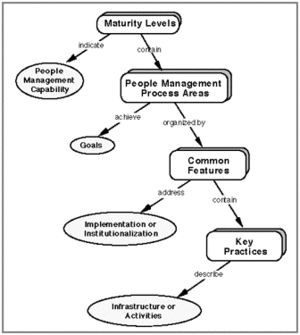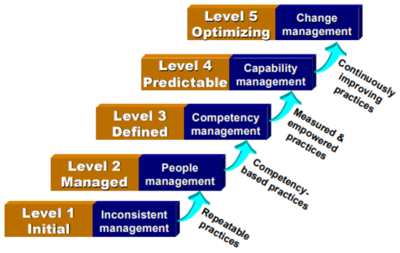People Capability Maturity Model (P-CMM)
People Capability Maturity Model PCMM® is an integrated set of best practices that improves performance and key capabilities for organizations that want to improve their critical people management processes. The People Capability Maturity Model® provides guidance for improving the capability of an organization’s workforce. These best practices help identify skill gaps, break down workflow bottlenecks, and empower team members to develop skills that will help the organization succeed.[1]
The People Capability Maturity Model (short names: People CMM, PCMM,P-CMM) consists of five maturity levels that establish successive foundations for continuously improving individual competencies, developing effective teams, motivating improved performance, and shaping the workforce the organization needs to accomplish its future business plans. Each maturity level is a well-defined evolutionary plateau that institutionalizes new capabilities for developing the organization's workforce. By following the maturity framework, an organization can avoid introducing workforce practices that its employees are unprepared to implement effectively. The People CMM has been published in book form.[2]

Figure 1. source: Wikipedia
Principles of People Capability Maturity Model (PCMM)[3]
The People Capability Maturity Model describes an evolutionary improvement path from ad hoc, inconsistently performed workforce practices, to a mature infrastructure of practices for continuously elevating workforce capability. The philosophy implicit the PCMM can be summarized in ten principles.
- In mature organizations, workforce capability is directly related to business performance.
- Workforce capability is a competitive issue and a source of strategic advantage.
- Workforce capability must be defined in relation to the organization’s strategic business objectives.
- Knowledge-intense work shifts the focus from job elements to workforce competencies.
- Capability can be measured and improved at multiple levels, including individuals, workgroups, workforce competencies, and the organization.
- An organization should invest in improving the capability of those workforce competencies that are critical to its core competency as a business.
- Operational management is responsible for the capability of the workforce.
- The improvement of workforce capability can be pursued as a process composed of proven practices and procedures.
- The organization is responsible for providing improvement opportunities, while individuals are responsible for taking advantage of them.
- Since technologies and organizational forms evolve rapidly, organizations must continually evolve their workforce practices and develop new workforce competencies.
The People Capability Maturity Model (People CMM) is a roadmap for implementing workforce practices that continuously improve the capability of an organization’s workforce. Since an organization cannot implement all of the best workforce practices in an afternoon, the People CMM introduces them in stages. Each progressive level of the People CMM produces a unique transformation in the organization’s culture by equipping it with more powerful practices for attracting, developing, organizing, motivating, and retaining its workforce. Thus, the People CMM establishes an integrated system of workforce practices that matures through increasing alignment with the organization’s business objectives, performance, and changing needs. Although the People CMM has been designed primarily for application in knowledge intense organizations, with appropriate tailoring it can be applied in almost any organizational setting. The People CMM’s primary objective is to improve the capability of the workforce. Workforce capability can be defined as the level of knowledge, skills, and process abilities available for performing an organization’s business activities.
PCCM - Process Maturity Rating[4]
The process maturity rating is from ad hoc and inconsistently performed practices, to a mature and disciplined development of the knowledge, skills, and motivation of the workforce. Traditionally, process maturity models like ISO/IEC 15504 or CMMI focus on organisational improvement with respect to operational (Product) Development Processes. PCMM in contrast focus instead on the three prominent factors for operational capability to deliver successful products and services:
- People
- Process
- Products, Technology

Figure 2. source: PlayInBusiness
Thus, these 3Ps of PCMM are comparable to ITIL's 4Ps: People, Processes, Products (tools and technology) and Partners (suppliers, vendors, and outsourcing organisations). P-CMM is characterised by a holistic approach to people-related issues. Instead of looking at traditional Human Resource interventions in a reactionary scrappy fashion. The P-CMM framework enables organisations to incrementally focus on key process areas and to lay foundations for improvement in workforce practices. Unlike other HR models, P-CMM requires that key process areas, improvements, interventions, policies, and procedures are institutionalized across the organisation — irrespective of function or level. Therefore, all improvements have to percolate throughout the organisation, to ensure consistency of focus, to place emphasis on a participatory culture, embodied in a team-based environment, and encouraging individual innovation and creativity.
People Capability Maturity Model (P-CMM) Maturity Levels[5]
A maturity level represents a new level of organizational capability created by the transformation of one or more domains of an organization’s processes. The People CMM applies the principles of the process maturity framework to the domain of workforce practices. Each of the People CMM’s five maturity levels represents a different level of organizational capability for managing and developing the workforce. Each maturity level provides a layer in the foundation for continuous improvement and equips the organization with increasingly powerful tools for developing the capability of its workforce. The nature of the transformation imposed on the organization’s workforce practices to achieve each level of maturity is depicted in Figure 3.

Figure 3. source: Software Engineering Institute
- The Initial Level: Maturity Level 1
Organizations at the Initial Level of maturity usually have difficulty retaining talented individuals. Even though many low-maturity organizations complain about a talent shortage, the inconsistency of their actions belies whether they actually believe it [Rothman 01]. Low-maturity organizations are poorly equipped to respond to talent shortages with anything other than slogans and exhortations. Despite the importance of talent, workforce practices in low-maturity organizations are often ad hoc and inconsistent. In some areas, the organization has not defined workforce practices, and, in other areas, it has not trained responsible individuals to perform the practices that exist.
- The Managed Level: Maturity Level 2
The workforce practices implemented at the Managed Level focus on activities at the unit level. The first step toward improving the capability of the workforce is to get managers to take workforce activities as high-priority responsibilities of their job. They must accept personal responsibility for the performance and development of those who perform the unit’s work. The practices implemented at Maturity Level 2 focus a manager’s attention on unit-level issues such as staffing, coordinating commitments, providing resources, managing performance, developing skills, and making compensation decisions. Building a solid foundation of workforce practices in each unit provides the bedrock on which more sophisticated workforce practices can be implemented at higher levels of maturity.
- The Defined Level: Maturity Level 3
Organizations at the Managed Level find that, although they are performing basic workforce practices, there is inconsistency in how these practices are performed across units and little synergy across the organization. The organization misses opportunities to standardize workforce practices because the common knowledge and skills necessary to conduct its business activities have not been identified. The primary objective of the Defined Level is to help an organization gain a competitive advantage by developing the various competencies that must be combined in its workforce to accomplish its business activities. These workforce competencies represent the critical pillars that support the strategic business plan; their absence poses a severe risk to strategic business objectives. In tying workforce competencies to current and future business objectives, the improved workforce practices implemented at Maturity Level 3 become critical enablers of business strategy.
- The Predictable Level: Maturity Level 4
An organization at the Defined Level has established an organizational framework for developing its workforce. At the Predictable Level, the organization manages and exploits the capability created by its framework of workforce competencies. This framework is sustained through formal mentoring activities. The organization is now able to manage its capability and performance quantitatively. The organization is able to predict its capability for performing work because it can quantify the capability of its workforce and of the competency-based processes they use in performing their assignments.
- The Optimizing Level: Maturity Level 5
At the Optimizing Level, the entire organization is focused on continual improvement. These improvements are made to the capability of individuals and workgroups, to the performance of competency-based processes, and to workforce practices and activities. The organization uses the results of the quantitative management activities established at Maturity Level 4 to guide improvements at Maturity Level 5. Maturity Level 5 organizations treat change management as an ordinary business process to be performed in an orderly way on a regular basis. At Maturity Level 5, individuals are encouraged to make continuous improvements to their personal work processes by analyzing their work and making necessary process enhancements. Similarly, workgroups are composed of individuals who have personalized work processes. To improve the capability of the workgroup, each person’s work processes must be integrated into an effective operating procedure for the workgroup. Improvements at the individual level should be integrated into improvements in the workgroup’s operating process. Mentors and coaches can be provided to guide improvements at both the individual and workgroup levels. Simultaneously, the organization continually seeks methods for improving the capability of its competency-based processes.
Benefits of People CMM®[6]
The above is a set of benefits observed in some of the organization that have implemented People CMM®. The adoption of the model:
- Drives a “systems” approach to its people related processes and initiatives
- Promotes a long-term thinking in terms of the people
- Increases transparency, democracy and openness
- Builds organizational agility and ability to execute cross-functional projects
- Increases the level of automation
- Makes the organization metrics and data analytics
- Drives a competency culture
- Enables handling of rapid growth and scale
- Makes the HR function become more of a business partner
- Transforms line managers to better people managers
See Also
- Human Resource Management (HRM)
- Human Capital Management (HCM)
- Human Resources Analytics (HR_Analytics)
- Human Resources
- Performance Management
- Applicant Tracking System (ATS)
- Personnel Management
- Capability Maturity Model (CMM)
- Capability Maturity Model Integration (CMMI)
References
- ↑ Definition of People Capability Maturity Model P-CMM? CMMI Institute
- ↑ What is People Capability Maturity Model (P-CMM) [1]
- ↑ 10 Principles of People Capability Maturity Model (PCMM) MBA Knowledge Base
- ↑ PCCM - Process Maturity Rating PlayInBusiness
- ↑ People Capability Maturity Model (P-CMM) Maturity Levels SEI
- ↑ Benefits of People CMM® AlignMentor
Further Reading
- Application and development of the people capability maturity model level of an organisation Yin-Che Chen & Yen-Jung Wang
- An Advanced Approach to People Capability Maturity Model John Bharali Baruah,, Nomi Baruah, Dipankar Dekaraja
- Case study on People Capability Maturity Model (PCCM): An Example of People and Bsiness Excellence KPMG
- People Capability Maturity Model (P-CMM) Version 2.0, Second Edition Software Engineering Institute
